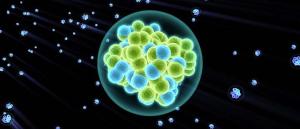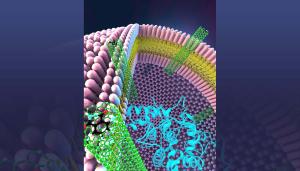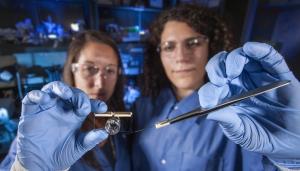LAB REPORT
Science and Technology Making Headlines
April 15, 2016


Many clouds surround the Southern Ocean. Lawrence Livermore scientists have found that climate models don’t accurately portray clouds and in turn underestimate global warming. Photo courtesy of NASA.
A cloudy outlook on global warming
The reflective power of clouds may be less effective at counteracting global warming than previously thought, according to new Lawrence Livermore research.
Scientists looked at clouds that contain both liquid and ice, known as mixed-phase clouds. Most climate models suggest that clouds will better be able to reflect light into space as global warming speeds up the melting of ice into a liquid in coming decades. Liquid water tends to reflect more light back into space than ice.
But the new research suggests that most models overestimate how much ice currently exists in mixed-phase clouds. That finding could dramatically increase the forecast speed of temperature rise in the coming decades, with temperatures more than 1 degree Celsius higher than anticipated in current models.
“The evidence is piling up against an overall stabilizing cloud feedback,” study co-author Mark Zelinka, of Lawrence Livermore National Laboratory “Clouds do not seem to want to do us any favors when it comes to limiting global warming.”

LLNL and colleagues are credited with the discovery of element 117 (shown here) and elements 115 and 118. Illustration by Kwei-Yu Chu/LLNL.
It’s all in a name
The International Union of Pure and Applied Chemistry (IUPAC) – which is kind of like the chemistry government – decided it was time to name the newest elements. Those would be numbers 113, 115, 117 and 118 on the periodic table.
While Japan received the naming rights for element 113, Lawrence Livermore and collaborators get the naming rights for elements 115, 117 and 118.
A team of scientists at the Joint Institute for Nuclear Research in Dubna, Russia and Lawrence Livermore National discovered all three, with some help from other labs for element 117. All of the good names that could have been plucked from that last sentence are taken. While Russian scientists have said naming the new elements is a “sensitive” topic, it would make sense to call one of the elements “oganessianium,” after Yuri Oganessian, who leads that Dubna lab. As for the U.S. picks, shaughnessium, after Lawrence Livermore team leader Dawn Shaughnessy, is a perfect fit for another of the elements.


A single chain of water molecules lines the cavity inside a carbon nanotube porin, which is embedded in a lipid bilayer. Image by: Y. Zhang and Alex Noy/LLNL.
Faster than flowing water
Lawrence Livermore researchers have shown that carbon nanotubes as small as eight-tenths of a nanometer in diameter can transport protons faster than bulk water, by an order of magnitude (a nanometer is one billionth of a meter. By comparison, the diameter of a human hair is 20,000 nanometers).
The transport rates in these nanotube pores, which form one-dimensional water wires, also exceed those of biological channels and man-made proton conductors, making carbon nanotubes the fastest known proton conductor.
Practical applications include proton exchange membranes, proton-based signaling in biological systems and the emerging field of proton bioelectronics (protonics).


Lawrence Livermore recently received the 16-chip IBM TrueNorth platform that can process the equivalent of 16 million neurons and 4 billion synapses. Photo courtesy of IBM.
The brains inside the supercomputer
A team from IBM Research-Almaden recently delivered a set of 16 interconnected TrueNorth chips built to mimic the ultra-low-energy, highly-parallel operation of the human brain to Lawrence Livermore National Laboratory. There, scientists and engineers will evaluate whether the technology could be a useful weapon in their computing arsenal.
It was a big moment for the IBM program, which devised the TrueNorth concept in 2010 and unveiled the first chip in 2014. Developed in collaboration with Cornell University, the TrueNorth chips use traditional digital components to implement a decidedly more brain-like behavior; each 5.4-billion-transistor chip can consume as little as 70 milliwatts.
Livermore, which has some of the world’s fastest supercomputers and signed a $1 million contract with IBM for the TrueNorth unit, will explore how this new technology might play a role in areas such as cybersecurity and physical simulation.

The diagram illustrates gas distribution as it leaks from the chimney of a nuclear test cavity for two different gases.
Sniffing out the bad guys
Through experiments and computer models of gas releases, Lawrence Livermore National Laboratory scientists have simulated signatures of gases from underground nuclear explosions (UNEs) that may be carried by winds far from the detonation.
Xenon-133 and Argon-37 often have been referred to as "smoking guns" for detecting clandestine underground explosions. These gases also percolate to the surface, where they can be detected during an inspection and are occasionally released into the atmosphere, where they can be detected by the International Monitoring System.
The work will help international inspectors locate and identify a clandestine UNE site within a 1,000-square-kilometer search area during an on-site inspection that could be carried out under the Comprehensive Nuclear Test Ban Treaty.





